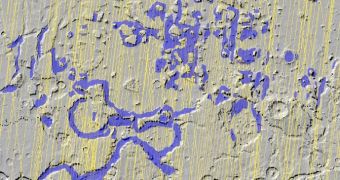Once scientists discovered that the poles of the Red Planet were covered in buried ice caps, they set out to find out whether the precious ice could be found anywhere else as well. They conducted an extensive mapping campaign of northern Mars' middle latitudes, using radars that could peer below the sand cover. These investigations determined that thick masses of thick ice were buried at these locations as well, also under a thin layer of sand. The studies essentially show that the idea that states that Mars was once a water-laden planet, featuring even an ocean, is actually very well rooted in historical truth.
These agglomerations of ice were detected for the first time more than two years ago. Since then, the NASA Mars Reconnaissance Orbiter (MRO) has been conducting investigations of hidden glaciers and ice-filled valleys regularly, providing new insight into the climate history of Mars with each of its orbits. The leading theory on why these ice accumulations endured at the new locations established on Mars is that retreating ice sheets left them behind billions of years ago. This is a common occurrence on Earth as well, where retreating glaciers leave behind a number of smaller ice patches in certain suitable locations, experts at the NASA Jet Propulsion Laboratory (JPL) announce.
“The subsurface ice deposits extend for hundreds of kilometers, or miles, in the rugged region called Deuteronilus Mensae, about halfway from the equator to the Martian north pole. Jeffrey Plaut of [JPL] and colleagues prepared a map of the region's confirmed ice for presentation at this week's 41st Lunar and Planetary Science Conference, near Houston. The Shallow Radar instrument on the orbiter has obtained more than 250 observations of the study area, which is about the size of California,” experts at the California Institute of Technology (Caltech) lab write on their official website.
“We have mapped the whole area with a high density of coverage. These are not isolated features. In this area, the radar is detecting thick subsurface ice in many locations. The hypothesis is the whole area was covered with an ice sheet during a different climate period, and when the climate dried out, these deposits remained only where they had been covered by a layer of debris protecting the ice from the atmosphere,” Plaut reveals. Because of the massive climate changes these ices endure, they are now considered to be one of the primary targets for future Martian exploration missions.

 14 DAY TRIAL //
14 DAY TRIAL //